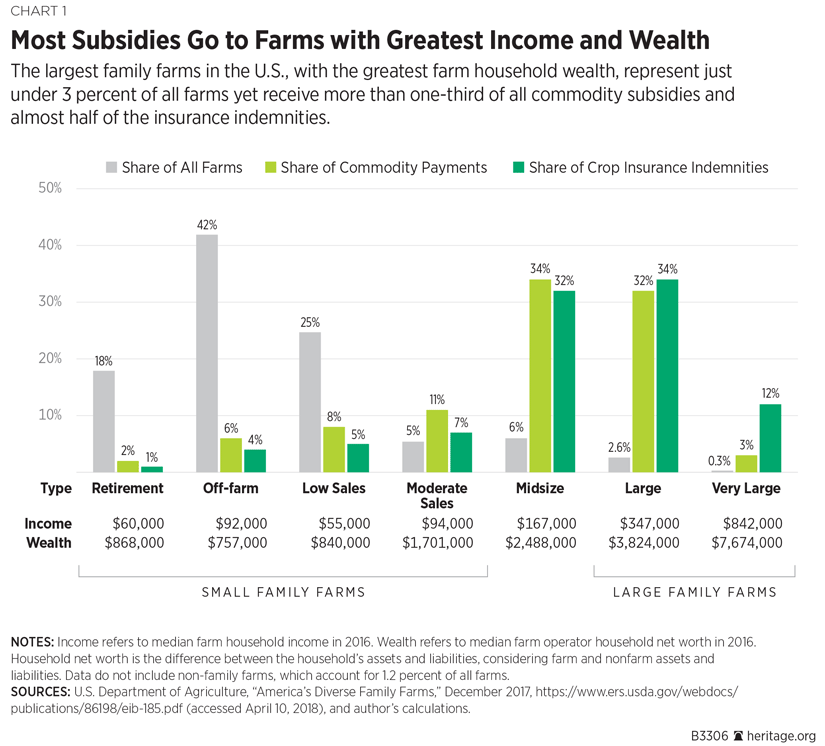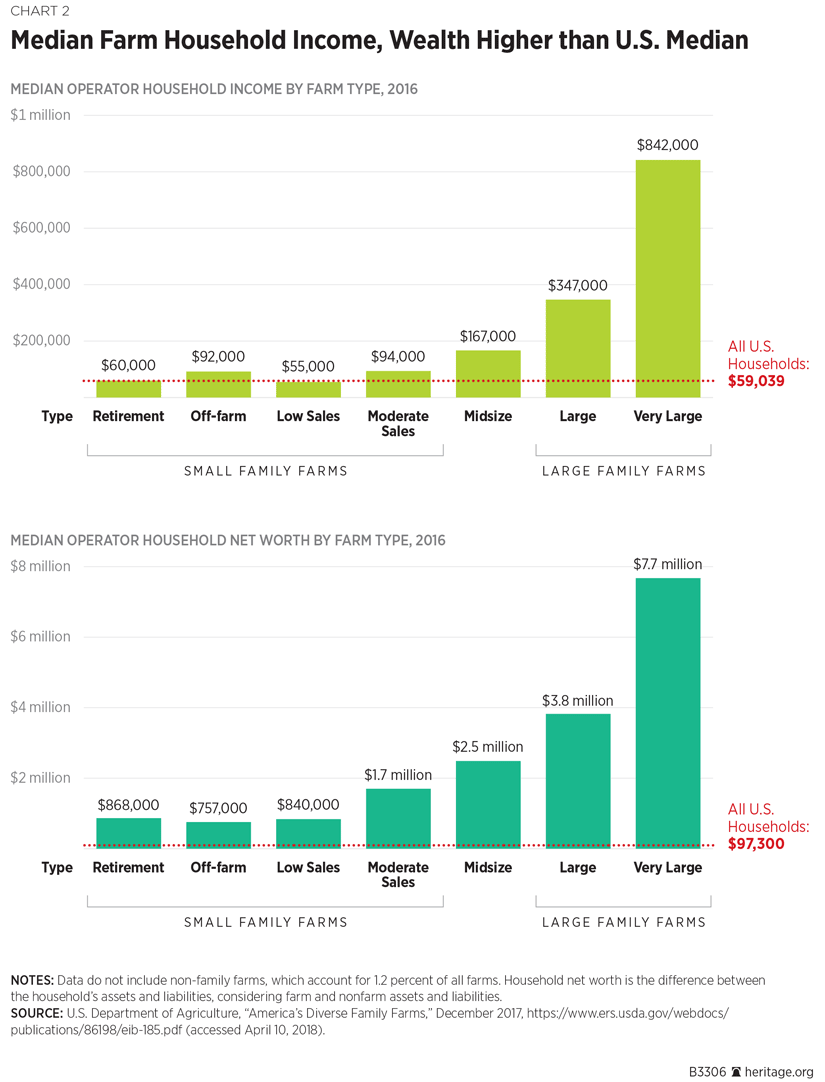Congress is currently working on its next farm bill. In crafting new farm policy, legislators should ignore harmful myths that undermine the development of sound agricultural policy, including myths regarding family farms and myths surrounding the recipients of farm subsidies. Agricultural special interests and the agriculture committees frequently try to paint a picture of the struggling family farmer trying to make ends meet. They use this image to help draw support for greater farm subsidies, as if these subsidies were a social welfare program to help poor farmers—as opposed to its (alleged) purpose of helping farmers manage agricultural risk. This is not the 1940s when farm household income was half that of nonfarm household income, and when farm handouts did act in part as a social welfare program.REF
This Backgrounder dispels some persistent myths regarding family farms, and uses U.S. Department of Agriculture (USDA) data to show that almost all of the farm subsidies go to large agricultural producers whose household income and wealth are extremely high, especially in comparison to U.S. households in general.
Dispelling Myths Regarding Family Farms
There are many myths surrounding family farms, including what constitutes a family farm. The term “family farm” simply means, as the USDA explains, “any farm where the majority of the business is owned by the principal operator—the person most responsible for running the farm—and individuals related to the principal operator.”REF “Family farm” is not a synonym for “small farm.” In fact, 90 percent of million-dollar farms were family farms in 2015.REF They also account for about 90 percent of farm production.REF
Family farms are also not disappearing. In fact, family farms account for about 99 percent of all farms.REF Further, the total number of farms in the U.S. has remained stable since the 1980s at about 2.1 million.REF
Fact: The Farm-Subsidy System Primarily Helps Large Agricultural Producers. The farm-subsidy system provides limited assistance to small family farms. In 2016, small family farms accounted for 89.9 percent of all farms, yet received 27 percent of commodity payments and 17 percent of crop insurance indemnities.REF
In contrast, commercial farms,REF which include the largest family farms, accounted for just 10.1 percent of all farms, yet received 73 percent of commodity payments and 83 percent of crop insurance indemnities.REF
Large-scale farms (large and very large family farms) accounted for just 2.9 percent of all farms, yet received over a third of the commodity payments (35 percent) and almost half of the crop insurance indemnities (46 percent).REF
Fact: Farm Households Have Much Greater Income and Wealth than All U.S. Households. Even looking at the income and wealth of all farm households, not just those receiving farm subsidies, the income and wealth numbers are staggering. In 2016, the median household income for all farms was $76,000, which is 29 percent greater than the median income for all U.S. households ($59,039).REF The median farm household wealth for all farms was $897,000, which is nine times greater than the median household wealth for all U.S. households ($97,300).REF
When looking at the income and wealth for farm households that receive most of these subsidies, the numbers become even more illuminating (see Charts 1 and 2).


Farm Household Income. Commercial family farms (midsize, large, and very large family farms), which received 69 percent of commodity payments and 78 percent of crop insurance indemnities, had a median household income of $167,000 or more in 2016.REF When breaking it down by type of commercial family farm:
- Midsize family farms, which received 34 percent of commodity payments and 32 percent of crop insurance indemnities, had a median household income of $167,000 (about triple the median income for all U.S. households).REF
- Large family farms, which received 32 percent of commodity payments and 34 percent of crop insurance indemnities, had a median household income of $347,000 (about six times the median income for all U.S. households).REF
- Very large family farms, which received 3 percent of commodity payments and 12 percent of crop insurance indemnities, had a median household income of $842,000 (about 14 times the median income for all U.S. households).REF
- Farm Household Wealth. Even when including some small family farms (“moderate sales” farms), the wealth numbers are shocking. As measured by the wealth (defined as net worthREF) of farm households, almost of all the commodity payments and crop insurance indemnities are going to millionaires and multi-millionaires.
Commercial family farms and moderate sales farms, which received 80 percent of commodity payments and 85 percent of crop insurance indemnities, had a median household wealth of $1.7 million or more in 2016.REF When breaking down the numbers by family farm type:
- Moderate-sales family farms, which received 11 percent of commodity payments and 7 percent of crop insurance indemnities, had a median household wealth of $1.7 million (about 17 times the median wealth for all U.S. households).REF
- Midsize family farms, which received 34 percent of commodity payments and 32 percent of crop insurance indemnities, had a median household wealth of $2.5 million (about 26 times the median wealth for all U.S. households).REF
- Large family farms, which received 32 percent of commodity payments and 34 percent of crop insurance indemnities, had a median household wealth of $3.8 million (about 39 times the median wealth for all U.S. households).REF
- Very large family farms, which received 3 percent of commodity payments and 12 percent of crop insurance indemnities, had a median household wealth of $7.7 million (about 79 times the median wealth for all U.S. households).REF
This massive wealth transfer takes money from taxpayers and hands it to households that generally have much greater income and wealth. There is a reverse Robin Hood effect. The problem is only getting worse over time, as a recent USDA report points out. For example, the report explains: “In 1991, half of commodity program payments went to farms operated by households with incomes over $60,717 (in constant 2015 dollars); however, in 2015, half went to households with incomes over $146,126.,” the USDA explained. “However, in 2015, half went to households with incomes over $146,126.”REF
Recommendations
So what should this massive wealth transfer mean in terms of policy? It does not mean that more subsidies should go to small farms. It also does not mean that subsidies should be precluded from going to the largest farms solely because of the high farm household income and wealth.REF It does mean that legislators should:
-
Not allow the myth of the struggling farmer to influence farm subsidies. Agricultural special interests try to conflate the issue of risk management and financial need. Farm subsidies are not a social welfare program. The only question on subsidies should be whether government intervention is necessary to help farmers manage agricultural risks.
-
Consider farm size and farm household income and wealth in determining the ability to manage risk. Regardless of size, farms should be able to manage risk without government intervention.REF However, the large size of farms and the high income and wealth of those operating the farms should inform decisions about whether those operations can better manage agricultural risk than smaller and less prosperous farm households. This might be the case due to factors such as economies of scale.
-
Make major subsidy reforms. Even assuming (incorrectly) that government intervention is necessary to help farmers manage risk, it is very difficult to justify the current level of subsidies when most agricultural producers succeed with little to no assistance. The Congressional Research Service recently pointed out that 94 percent of farm program support goes to just six commodities (corn, cotton, peanuts, rice, soybeans, and wheat), which account for only about 28 percent of total farm receipts.REF In other words, about three-fourths of all agricultural production receives 6 percent of the farm program support.
It is also very difficult to justify providing multiple subsidies to cover the same losses, to cover shallow losses (minor losses), or to insulate farmers from competing in the market like other businesses. The high income and wealth of farm households receiving most subsidies, as outlined in this Backgrounder, simply make these types of indefensible subsidies even more indefensible. After all, forcing taxpayers to provide inappropriate subsidies is bad enough. It is even worse that these subsidies are primarily going to millionaires and multimillionaires as measured by the net worth of farm households.
Congress should make major changes to farm subsidies in the next farm bill. Ideally, these changes would include treating the small number of farmers receiving almost all of the farm program support the same as most agricultural producers. This means providing little to no assistance, and if assistance is provided, it would only help producers when they experience major losses due to disasters.
Conclusion
Any subsidies provided to farmers should be based on whether they are clearly necessary to manage agricultural risks, not on the myths regarding struggling farmers. Legislators should take a step back and ask the right questions, including:
- Are farm subsidies necessary to help farmers manage agricultural risk?
- Are farm subsidies properly focused on helping those farmers when they have a real need?
- Are subsidies providing a true safety net or has the system become a crony scheme to primarily help a small number of large producers with high farm household income and wealth?
If policymakers do ask these questions, they will likely reach the same conclusion that legislators and organizations across the ideological spectrum have reached: Farm subsidies are in dire need of major reform in the upcoming farm bill.
—Daren Bakst is Senior Research Fellow in Agricultural Policy in the Thomas A. Roe Institute for Economic Policy Studies, of the Institute for Economic Freedom, at The Heritage Foundation.
Appendix: Types of Farms[REF]
Small Family Farms (Gross Cash Farm Income (GCFI) less than $350,000)
- Retirement farms. Small farms whose principal operators report they are retired, although they continue to farm on a small scale.
- Off-farm occupation farms. Small farms whose principal operators report a major occupation other than farming.
- Farming-occupation farms. Small farms whose principal operators report farming as their major occupation.
- Low sales. GCFI less than $150,000. Moderate sales. GCFI between $150,000 and $349,999.
Midsize Family Farms (GCFI between $350,000 and $999,999)
- Family farms with GCFI between $350,000 and $999,999.
Large Scale Family Farms (GCFI of $1,000,000 or more)
- Large family farms. Farms with GCFI between $1,000,000 and $4,999,999.
- Very large family farms. Farms with GCFI of $5,000,000 or more.
Non-Family Farms
- Any farm where the principal operator and persons related to the principal operator do not own a majority of the business.


